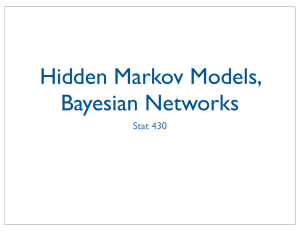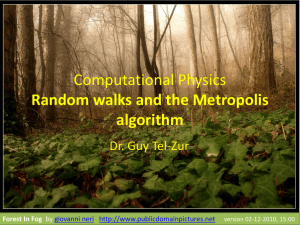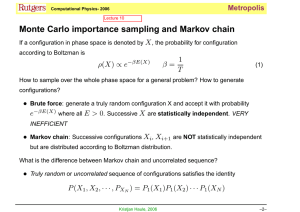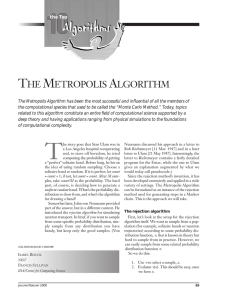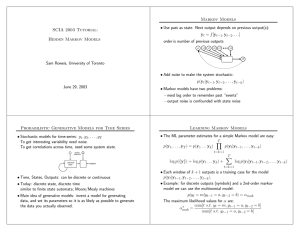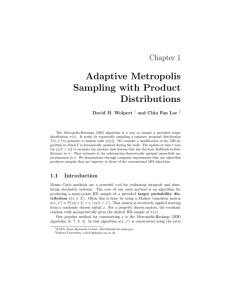Outline Hidden Markov Models, Metropolis Hastings •
advertisement
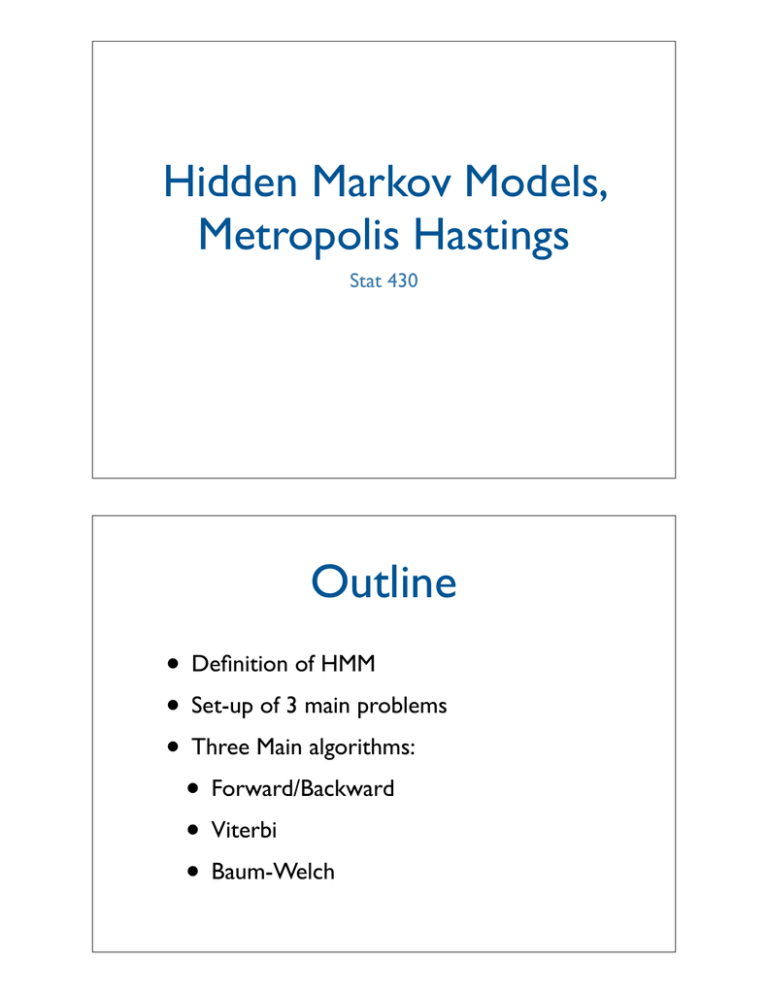
Hidden Markov Models,
Metropolis Hastings
Stat 430
Outline
• Definition of HMM
• Set-up of 3 main problems
• Three Main algorithms:
• Forward/Backward
• Viterbi
• Baum-Welch
Definition
A hidden Markov model (HMM) consists of
• set of states S , S , ..., S
• the transition matrix P with
1
2
N
pij = P(qt+1 = Sj| qt=Si)
• an alphabet of M unique, observed symbols
A = {a1, ..., aM}
• emission probabilities
bi(a) = P(state Si emits a)
• initial distribution π = P(q
i
1
= Si )
Three Main Problems
•
Find P(O)
computational problem: naive solution is intractable
foward-backward algorithm
•
Find the sequence of states that most likely
produced observed output O:
argmaxQ = P(Q|O)
Viterbi algorithm
•
for fixed topology find P, B and π that maximize
probability to observe O
Baum-Welch algorithm
CAEFTPAVH, CKETTPADH, CAETPDDH, CAEFDDH, CDAEFPDDH
HMM for Amino Acid/Gene
Sequences
d1
d2
d3
i0
i1
i2
i3
m0
m1
m2
m3
CAEFTPAVH, CKETTPADH, CAETPDDH, CAEFDDH, CDAEFPDDH
Example
•
CAEFDDH most likely produced by
m0 m1 m2 m3 m4 d5 d6 m7 m8 m9 m10
•
CDAEFPDDH most likely produced by
m0 m1 i1 m2 m3 m4 d5 m6 m7 m8 m9 m10
•
Yields alignment
C -AEF - -DDH
CDAEFP -DDH
m4
R packages
• HMM
• RHmm
• HiddenMarkov
• msm
• depmix, depmixS4
• flexmix
Metropolis Hastings
Algorithm
• Motivation:
we want to sample from distribution F
• Previously we did that with Acceptance/
Rejection sampling, with independent
samples.
• Now: Generate correlated random variables
instead of independent ones.
• Gives us improved efficiency
Extension to Markov
Chains
• Allow state space to be infinite (all of R):
• X , X , … ,X X is sequence of
0
1
t,
t+1, …
dependent variables, such that distribution
of Xt+1 only depends on value of Xt.
Markov Kernel K(Xt, Xt+1)
• e.g. :
random walk: Xt+1 = Xt+ ε, with ε ~ N(0,1)
Continuous Markov
Chains
• Small variation of random walk:
Xt+1 = rXt+ ε, with ε ~ N(0,1) with r < 1 and
X0 ~ N(0,1)
has large t distribution N(0, 1/(1-r2))
• Ergodic Markov Chains (irreducible, aperiodic
and positive recurrent) have a stationary
distribution, i.e.:
limT 1/T ∑t h(Xt) = E(h(X))
Metropolis Hastings
•
•
target density f
•
algorithm:
conditional density q
(easy to simulate, e.g. uniform)
•
given xt
•
•
generate yt ~ q(y|xt)
xt+1 = yt with probability α and
xt+1 = xt with probability 1 - α
where
α = min(1, f(yt)/f(xt) * q(xt|yt)/q(yt|xt))
Metropolis Hastings
• q is called proposal or instrumental
distribution
•
α is acceptance probability
Example: inverse χ2
• inverse χ
2 density:
f(x) = x(-k/2)exp(-a/(2x))
• for k = 5, a = 4:
0.14
0.12
f(x, k, a)
0.10
0.08
0.06
0.04
0.02
5
x
10
15
20
3500
3000
count
2500
Example
2000
1500
100
1000
500
0
40
60
met
80
100
40
60
20
20
met[1:1000]
80
0
0
• Top:
0
200
400
600
800
1000
Index
proposal distribution uniform U[0,100],
long stretches of same random number:
chain is poorly mixed
1200
1000
count
400
200
0
2
4
met
6
8
10
6
4
met[1:500]
8
10
0
2
Bottom: proposal
distribution is χ2
with df=1
600
0
•
800
0
100
200
300
Index
400
500
Metropolis Hastings
•
Very general algorithm:
simulate distribution f from any other distribution q
•
•
xt are not independent (because of the repetitions)
•
pick proposal distribution based on sd:
large sd -> large jumps, poor acceptance
too small sd -> small jumps, high autocorrelation
sample chain’s quality dependent on proposal
distribution
Gibbs Sampling
• Goal: target distribution
F(Y1,Y2, ...,Yk)
• Algorithm:
•
•
Given xt = (x1, x2, ..., xk)
X1t+1 ~ f(x1| x2t, ..., xkt)
X2t+1 ~ f(x2| x1t+1, x3t, ..., xkt)
...
Xkt+1 ~ f(xk| x1t+1, ..., xk-1t+1)


